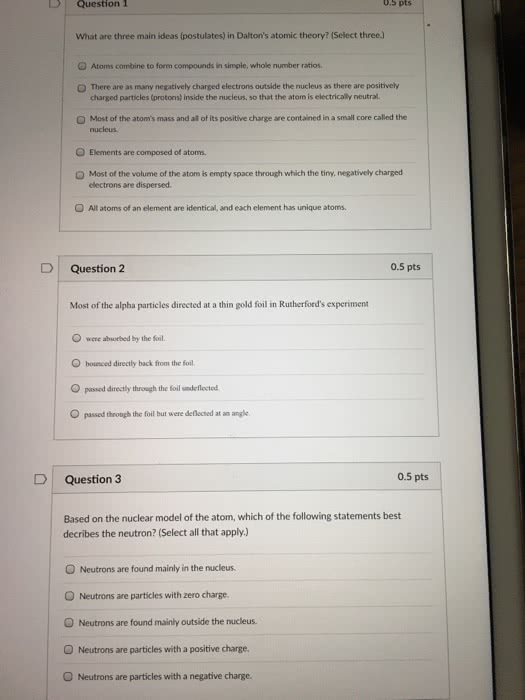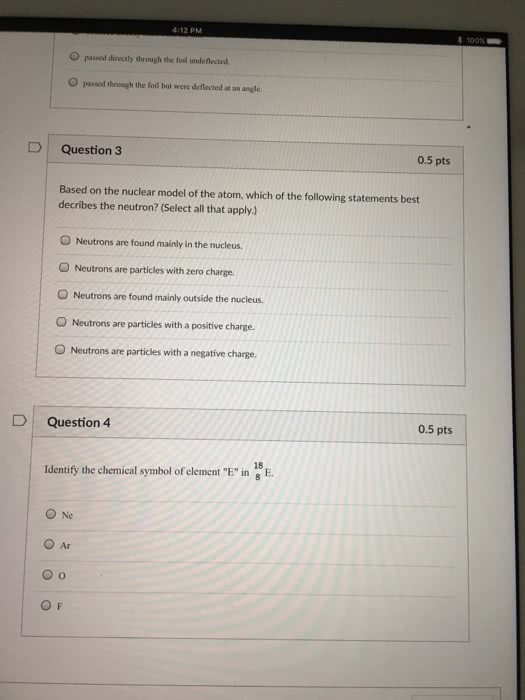CAS CH 171 Lecture Notes - Lecture 4: Decay Product, Beta Particle, Electromagnetic Radiation

Isotopes
• Have the same number of protons but a different amount of neurons
• Two groups:
• Stable Combinations (of protons and neutrons)
• Unstable Combinations (of protons and neutrons)
• Radioactive
Review - AZE
• Mass number (‘Z’)
• Usually located at the bottom left of element symbol
• # of protons + # of neutrons
• Atomic number (‘A’)
• Usually located at the top left of element symbol
• # of protons
Nuclear Radiation Particles
• Type of Radiation:
• Alpha (mass number = 4, charge = +2)
• Helium nuclei, 2 protons + 2 neutrons
• Beta (mass number = 0, charge = -1)
• Electrons produced in nucleus and ejected
• Gamma (mass number = 0, charge = 0)
• Electromagnetic radiation
• Neutron (mass number = 1, charge = 0)
• Neutrons
• Positron (mass number = 0, charge = +1)
• Positive electrons (same mass number of an electron, but positively charged)
Balancing Nuclear Reactions
• X + Y —> D
• AZX + AZY —> AZX
• Mass = ‘A’, Change = ‘Y’
• ex: 23892U + 42E —> 23490Th
• Essentially, you want all the lines to add up
• If it is a composition reaction, you want the reactants to add up to the product
• If it is a decomposition reaction, you want the products to add up to the reactant
* daughter nucleus = particle that is emitted
1. ex: Bromine-84 decays by emitting a beta particle. What daughter nucleus remains?
answer: 84Kr
work: 8435Br —> 0-1(beta) + 8436Kr
2. ex: When samarium-148 (Sm) undergoes radioactive decay, the daughter produced is neodymium-144
(Nd). What kind of radiation is emitted?
answer: 14862Sm —> 4+2(alpha) + 14460Nd
find more resources at oneclass.com
find more resources at oneclass.com
Document Summary
Isotopes: have the same number of protons but a different amount of neurons, two groups, stable combinations (of protons and neutrons, unstable combinations (of protons and neutrons, radioactive. Ze: mass number ( z", usually located at the bottom left of element symbol, # of protons + # of neutrons, atomic number ( a", usually located at the top left of element symbol, # of protons. Balancing nuclear reactions: x + y > d, a. Zx + a: mass = a", change = y", ex: 238. * daughter nucleus = particle that is emitted: ex: bromine-84 decays by emitting a beta particle. What daughter nucleus remains? answer: 84kr work: 84: ex: when samarium-148 (sm) undergoes radioactive decay, the daughter produced is neodymium-144 (nd). What kind of radiation is emitted? answer: 148. How long will it take (in minutes) 100. 0 g of k-38 to reduce to 25. 0 g? work/answer: (25g)/(100g) = (1/4)n = (1/2)2 n = 2 (*2 - 2 half lives*)



